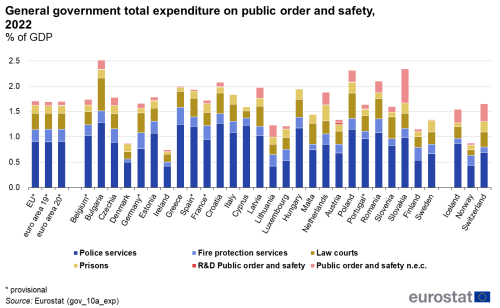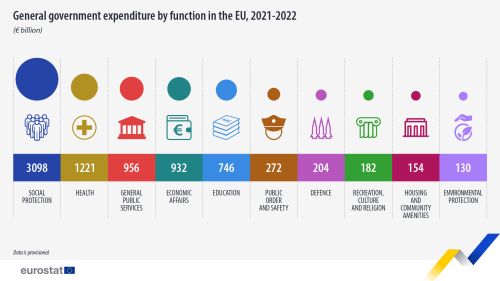Government expenditure on public order and safety
Data extracted on 29 February 2024
Planned article update: February 2025
Highlights
General government expenditure in the EU on public order and safety stood at 1.7 % of GDP in 2022.

Source: Eurostat (gov_10a_exp)
This article analyses data on general government expenditure on 'public order and safety' (according to the Classification of the Functions of Government - COFOG). It is part of a set of statistical articles based on general government expenditure by function.
Eurostat collects data on general government expenditure by economic function according to the international Classification of the Functions of Government (COFOG) in the framework of the European System of National Accounts (ESA 2010).
Full article
Expenditure on 'public order and safety'
Expenditure on 'public order and safety comprises the following categories: 'police services', 'fire protection services', 'law courts', 'prisons', 'R&D related to public order and safety' as well as expenditure not elsewhere classified.

Source: Eurostat (gov_10a_exp)
At the level of the EU, general government total expenditure on 'public order and safety' in 2022 stood at 1.7 % of GDP. Within this COFOG division, the equivalent of 0.9 % of GDP was spent on 'police services', as the most significant COFOG group in this division by expenditure. Around 0.3 % of GDP was accounted for by expenditure on 'law courts' and 0.2 % of GDP each on 'fire protection services' (including civil protection operations such as dealing with flooding, mountain rescue, beach surveillance) and 'prisons'.
In 2022, the level of expenditure on 'public order and safety' as a percentage of GDP was the highest in Bulgaria (2.5 % of GDP) followed by Slovakia and Poland (both 2.3 % of GDP), Romania and Croatia (both 2.1 % of GDP), Greece, Latvia and Hungary (all 2.0 % of GDP); it was the lowest in Ireland (0.7 % of GDP), Denmark (0.9 % of GDP), Finland, Luxembourg and Lithuania (all 1.2 % of GDP), Austria and Sweden (both 1.3 % of GDP), as well as Norway (0.9 % of GDP).
As a ratio to GDP, Bulgaria and Croatia (both 1.3 % of GDP) spent the highest amount on police services followed by Greece, Cyprus, Spain and Hungary (all 1.2 % of GDP). This group comprises also expenditure on the operation of border and coast guards.
Expenditure on fire protection services ranged between 0.1 % and 0.3 % of GDP in 2022, with the highest ratios reported by Greece, Germany, France, Romania and Czechia.
Expenditure on 'law courts', which comprises expenditure on the operation of courts and the justice system, in the EU was highest in Bulgaria (0.7 % of GDP) followed by Poland (0.5 % of GDP), Slovenia, Malta, Croatia, Latvia, Romania, Germany and Spain (all 0.4 % of GDP), while for the rest of the reporting countries the ratio ranged between 0.1 % and 0.3 % of GDP in 2022.
Expenditure on prisons ranged between 0.05 % and 0.2 % of GDP in all countries except the Netherlands (0.3 % of GDP) in 2022.
Expenditure on public order and safety by type of transaction
At the level of the EU, by far the largest part of expenditure on 'public order and safety' in 2022 was on 'compensation of employees' (70 % of total expenditure), i.e. wages, salaries and employers' social contributions for staff working in this field, for example, police, judges, firemen and prison guards. 'Intermediate consumption' (including expenditure on outsourcing services) made up about 20 % of total expenditure and capital investments about 7 %.
Source data for tables and graphs
The detailed tables ![]() are available here.
are available here.
Data sources and availability
Reporting of data to Eurostat
Annual government finance statistics (GFS) data are collected by Eurostat on the basis of the European System of Accounts (ESA 2010) transmission programme. Member States are requested to transmit, among other tables, table 1100, 'Expenditure of general government by function' twelve months after the end of the reference period. Table 1100 provides information about expenditure of the general government sector divided into main COFOG functions and ESA 2010 categories. The transmission of the COFOG I level breakdown (divisions) is compulsory for the years 1995 onwards, whereas information on the COFOG II level (COFOG groups) is provided on a compulsory basis for the general government sector from the reference years 2001 onwards. The main reference year used in this publication is 2022 as the latest year available at EU level.
Data was extracted on 29 February 2024.
Provisional data
While a significant effort was undertaken to harmonise the recording of government measures to alleviate the impact of increasing energy prices, a full harmonisation of data for the reference year 2022 was not yet achieved.
Data for the EU and euro area aggregates (2022), Belgium (2022), Germany (2020-2022), Spain (2022), France (2021-2022) and Portugal (2022) is provisional.
Definition of general government and its subsectors
The data relate to the general government sector of the economy, as defined in ESA 2010, paragraph 2.111: 'The general government sector (S.13) consists of institutional units which are non-market producers whose output is intended for individual and collective consumption, and are financed by compulsory payments made by units belonging to other sectors, and institutional units principally engaged in the redistribution of national income and wealth’.
Classification of functional expenditure of government
The Classification of the Functions of Government (COFOG) classifies government expenditure into ten main categories (divisions known as the 'COFOG I level' breakdown): general public services; defence; public order and safety; economic affairs; environmental protection; housing and community affairs; health; recreation, culture and religion; education; social protection. These divisions are further broken down into 'groups' (COFOG II level).
For 'public order and safety', the groups are
- 'police services',
- 'fire protection services',
- 'law courts',
- 'prisons',
- 'R&D public order and safety',
- 'public order and safety n.e.c.'.
Further information is available in the Eurostat Manual on sources and methods for the compilation of COFOG Statistics.
Satellite accounts
Administrative expenditure data is additionally collected in so-called satellite accounts. In general, the amount of expenditure recorded in satellite accounts is expected to exceed the expenditure recorded under the respective COFOG division. More details on the comparability of COFOG data with satellite accounts data can be found in the COFOG manual.
Definition of general government total expenditure
Government total expenditure is defined in ESA 2010, paragraph 8.100 by using as reference a list of ESA 2010 categories. More detail is provided in the overview article on Government expenditure by function – COFOG.
Gross Domestic Product
Throughout this publication, the nominal GDP, i.e. GDP at current prices is used. The latest GDP available at time of publication is used.
Time of recording & symbols used
In the ESA 2010 system, recording is on an accrual basis, that is, when ‘economic value is created, transformed or extinguished, or when claims and obligations arise, are transformed or are cancelled.'
":" not available
"pp" percentage points
More data and information
For more country-specific notes, e.g. on missing data, please refer to the metadata published on Eurobase. The authors can be contacted at ESTAT-GFS@ec.europa.eu
Context
In the framework of the European System of National Accounts (ESA 2010), Eurostat collects data on general government expenditure by economic function according to the international Classification of the Functions of Government (COFOG) – see methodological note.
Direct access to
- Government expenditure by function - online publication
- Government expenditure by function – COFOG - overview article
- Government statistics (t_gov)
- Annual government finance statistics (t_gov_10a)
- Government statistics (gov)
- Government finance statistics (EDP and ESA2010) (gov_gfs10)
- Annual government finance statistics (gov_10a)
- Government revenue, expenditure and main aggregates (gov_10a_main)
- General government expenditure by function (COFOG) (gov_10a_exp)
- Main national accounts tax aggregates (gov_10a_tax_ag)
- Annual government finance statistics (gov_10a)
- Government finance statistics (EDP and ESA2010) (gov_gfs10)
- Government revenue, expenditure and main aggregates (ESMS metadata file — gov_10a_main_esms)
- General government expenditure by function (COFOG) (ESMS metadata file — gov_10a_exp_esms)
- Manual on sources and methods for the compilation of COFOG statistics - Classifications of the Functions of Government - 2019 edition
- Manual on government deficit and debt — implementation of ESA 2010 — 2022 edition
